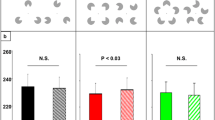Abstract
A method for evaluating the fusional reserves has been developed and tested. The method employs an interactive computer program permitting the checking of the subject’s report at the moment of fusion failure during an artificial increase in the convergence or divergence of the visual axes in the course of measurement. The control is based on the use of purely binocular stimuli (random-dot stereograms, RDSs) and dynamic markers, which are added to the test object (TO) in a random order during the measurement procedure and changes in the shape of the TO. The TO with a marker encoded in the stereogram is only perceived owing to binocular mechanisms, and it becomes invisible if fusion has been disturbed. Its disappearance allows the subject to determine the moment of fusion failure, and the shape of the object with the marker before this moment allows the experimenter to check the subject’s report. Statistical analysis of the results of the primary and secondary measurements of the fusional reserves of 72 subjects has confirmed that the method is sufficiently reliable.
Similar content being viewed by others
References
Rozenblyum, Yu.Z., Optometriya (Optometry), St. Petersburg: Gippokrat, 1996.
Cooper, J.S., Burns, C.R., Cotter, S.A., Daum, K.M., Griffin, J.R., and Scheiman, M.M., Care for the Patient with Accommodative and Vergence Dysfunction: Optometric Clinical Practice Guideline, Healthy Vision, 2000.
Evans, B.J.W., Pickwell’s Binocular Vision Anomalies, Oxford: Butterworth-Heinemann, 1997.
Somov, E.E., Metody oftal’moergonomiki (Methods of Ophthalmological Ergonomics), Leningrad: Nauka, 1989.
Kashchenko, T.P. and Dolbishcheva, V.M., A Set of Test Objects for a Synoptophore, Nov. Med. Tekh., 1977, no. 2, p. 14.
Vasiljeva, N.N. and Rozhkova, G.I., Age Dynamics of Fusion Capabilities Assessed by Means of RDS with Markers for Objective Control of Binocular Image Splitting, Perception, 2008, vol. 37,suppl., p. 102.
Vasiljeva, N.N. and Rozhkova, G.I., Age Dynamics of Fusion Capabilities Assessed by Means of Cyclopean Test Objects with Markers, Sens. Sist., 2009, vol. 23, no. 1, pp. 40–50.
Author information
Authors and Affiliations
Additional information
Original Russian Text © G.I. Rozhkova, N.N. Vasiljeva, 2010, published in Fiziologiya Cheloveka, 2010, Vol. 36, No. 3, pp. 135–137.
Rights and permissions
About this article
Cite this article
Rozhkova, G.I., Vasiljeva, N.N. A computer-aided method for the evaluation of fusional reserves with objective control of fusion break. Hum Physiol 36, 364–366 (2010). https://doi.org/10.1134/S0362119710030187
Received:
Published:
Issue Date:
DOI: https://doi.org/10.1134/S0362119710030187




